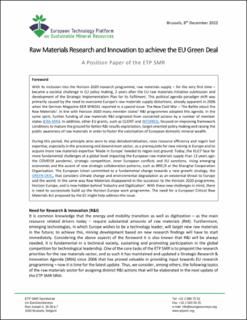| dc.description.abstract | Foreword With its inclusion into the Horizon 2020 research programme, raw materials supply – for the very first time – became a societal challenge in EU policy making, 2 years after the EU raw materials initiative submission and development of the Strategic Implementation Plan for its fulfilment. This political agenda paradigm shift was primarily caused by the need to overcome Europe’s raw materials supply distortions, already apparent in 2006 when the German Magazine DER SPIEGEL reported in a special issue: The New Cold War – The Battle about the Raw Materials1. In line with Horizon 2020 many member states’ R&I programmes adopted this agenda. In the same spirit, further funding of raw materials R&I originated from concerted actions by a number of member states (ERA-MIN). In addition, other EU grants, such as CLIENT and INTERREG, focused on improving framework conditions to mature the ground for better R&I results exploitation, target oriented policy making and raising the public awareness of raw materials in order to foster the valorisation of European domestic mineral wealth. During this period, the principle aims were to stop deindustrialisation, raise resource efficiency and regain lost expertise, especially in the processing and downstream sector, as a prerequisite for new mining in Europe and to acquire more raw materials expertise ‘Made in Europe’ needed to regain lost ground. Today, the EU27 face far more fundamental challenges at a global level impacting the European raw materials supply than 12 years ago: the COVID19 pandemic, strategic competition, inner European conflicts and EU sanctions, rising emerging economies and the ascent of new strategic collaboration patterns, such as BRIC/S or the Shanghai Cooperation Organisation. The European Union committed to a fundamental change towards a new growth strategy, the GREEN DEAL, that considers climate change and environmental degradation as an existential threat to Europe and the world. In the same way Raw Materials disappeared in the successor to the Horizon 2020 programme, Horizon Europe, and is now hidden behind ‘Industry and Digitization’. With these new challenges in mind, there is need to successively build up the Horizon Europe work programme. The need for a European Critical Raw Materials Act proposed by the EC might help address this issue. | en_US |
